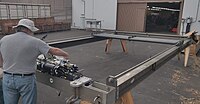17:
48:
with a speed of up to 2.5 knots (1.3 m/s) and consists of five to twenty nets with a mesh size from 64 μm to 3 mm and an area of 0.25 to 20 m (although the last one is a 2x10 m systems) which are opened and closed computer controlled at desired depth. The net enables biologists to
57:
in various depth horizons typically anywhere in the upper 6000 m of the oceans. All MOCNESS systems are capable of sampling to 6000 meters depth (10,000 psi). The system includes SeaBird probes to measure salinity and temperature at sampling depths, as well as optional dissolved oxygen,
109:
Wiebe, P. H.; Morton, A. W.; Bradley, A. M.; Backus, R. H.; Craddock, J. E.; Barber, V.; Cowles, T. J.; Flierl, G. R. (1985). "New development in the MOCNESS, an apparatus for sampling zooplankton and micronekton".
59:
36:
and particles in the ocean. Consisting of 5-20 nets of variable mesh sizes, it is useful for collecting samples at multiple depths and sizes.
85:
81:
physiochemical measurements transmitted to the on-board laboratory to confirm net depth and water properties.
138:
210:
184:
176:
119:
78:
45:
189:
164:
204:
89:
71:
62:(photosynthetically available light), transmissometry and fluorescence sensors.
50:
16:
180:
92:
was found negatively buoyant at depth and therefore sinking from the surface.
77:
to collect zooplankton samples from 4,000 metres (13,000 ft) deep, with
33:
165:"First evidence of plastic fallout from the North Pacific Garbage Patch"
163:
Egger, Matthias; Sulu-Gambari, Fatimah; Lebreton, Laurent (6 May 2020).
123:
88:
in 2018. By closing nets of variable mesh sizes at different depths,
54:
84:
A MOCNESS was used to investigate sinking plastic particles at the
15:
30:
Multiple
Opening/Closing Net and Environmental Sensing System
8:
70:In 2008, a MOCNESS system was used on the
188:
20:A MOCNESS system with the nets taken off
101:
7:
14:
66:Example cruises and discoveries
139:"Sampling the Atlantic depths"
1:
44:The system is towed behind a
137:Grieve, Janet (March 2008).
32:) is a towed net system for
86:North Pacific Garbage Patch
227:
181:10.1038/s41598-020-64465-8
146:Water & Atmosphere
21:
19:
90:microplastic debris
169:Scientific Reports
124:10.1007/BF00397811
22:
218:
195:
194:
192:
160:
154:
153:
143:
134:
128:
127:
106:
40:Design and usage
226:
225:
221:
220:
219:
217:
216:
215:
201:
200:
199:
198:
162:
161:
157:
141:
136:
135:
131:
108:
107:
103:
98:
68:
46:research vessel
42:
12:
11:
5:
224:
222:
214:
213:
203:
202:
197:
196:
155:
129:
118:(3): 313–323.
112:Marine Biology
100:
99:
97:
94:
67:
64:
41:
38:
13:
10:
9:
6:
4:
3:
2:
223:
212:
209:
208:
206:
191:
186:
182:
178:
174:
170:
166:
159:
156:
151:
147:
140:
133:
130:
125:
121:
117:
113:
105:
102:
95:
93:
91:
87:
82:
80:
76:
75:
65:
63:
61:
56:
52:
47:
39:
37:
35:
31:
28:(acronym for
27:
18:
172:
168:
158:
149:
145:
132:
115:
111:
104:
83:
73:
69:
43:
29:
25:
23:
211:Planktology
175:(1): 7495.
152:(1): 14–15.
51:zooplankton
96:References
74:Polarstern
205:Category
34:plankton
190:7203237
26:MOCNESS
187:
55:nekton
49:catch
142:(PDF)
72:PFS
53:and
24:The
185:PMC
177:doi
120:doi
79:CTD
60:PAR
207::
183:.
173:10
171:.
167:.
150:16
148:.
144:.
116:87
114:.
193:.
179::
126:.
122::
Text is available under the Creative Commons Attribution-ShareAlike License. Additional terms may apply.
